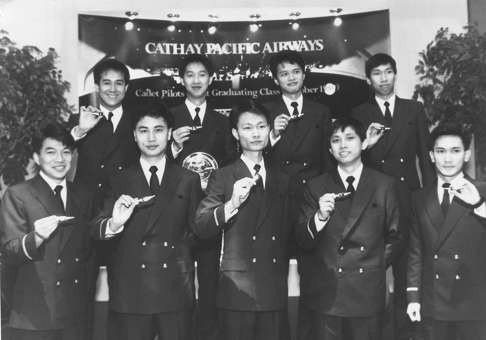
Hong Kong has an aviation labour shortage because companies don’t pay enough - except for pilots
Airport jobs will double to 15,000 when the third runway gets built in eight years, but companies may find it difficult to fill vacancies unless they raise wages
At the annual Hong Kong International Airport Career Expo over the weekend, one can easily find the Cathay Pacific cadet pilot programme booth - that is by far the busiest booth besieged by young men - and a few young women. Standing in the middle are Cathay pilots Allen, Clive and Michael, who are bombarded with questions on how to get into the programme that trains people with zero aviation experience how to fly, expenses paid.
That was also the corner in the exhibition hall offering the highest-paying jobs. Monthly pay of a Second Officer at Cathay, the most junior rank, starts at around HK$50,000, according to the airline. Most of the more than 3,000 entry-level airport-based jobs from 40 employers presented at the expo don’t pay anywhere near that. Become a Dragonair flight attendant, you would earn monthly salary of between HK$16,000 to HK$17,000; Or become a customer service representative at the Hong Kong Business Aviation Centre for “maximum HK$20,000” a month, according to promotional information.

More than 73,000 people work within the airport area, a number that Secretary for Labour and Welfare Matthew Cheung Kin-chung said should double when the third runway gets built in eight years. However, companies may find it difficult to fill some of those jobs unless they raise their pay.
Hong Kong Airlines, which is on an aggressive expansion, plans to add 1,000 jobs this year, almost one third of its current size of 3,300. About 600 positions are for the airline and 400 for its newly-established ground service subsidiary HAGSL. “Maintenance positions are among the hardest to fill,” chief operating officer Ben Wong said. “There is a lot of demand for engineers and mechanics for complicated planning and technical services at every airline,” he said.
While Hong Kong Polytechnic University and the University of Science and Technology both have degree programmes in aviation engineering, mechanics are mainly trained by the three biggest maintenance companies, the Vocational Training Council, or the airlines themselves.
The government in January said it would establish a Civil Aviation Academy, but details of what kind of training the academy would offer is still under discussion, the Airport Authority’s acting chief executive CK Ng said.
Hong Kong Aircraft Engineering Company, the aviation maintenance company owned by Swire, has been suffering from labour shortage for years. Lack of attractive pay to keep workers in jobs at remote airport island is one reason why many have been jumping ship to companies such as the MTR and the CLP Group, which require similar skills, according to industry insiders.
However, HAECO said its labour shortage situation “has been solved” and that it is looking to recruit 320 frontline staff this year. Its aircraft maintenance craftsman trainees with DSE qualification earn a monthly salary of around HK$14,360 and HK$17,200 upon graduation of the one-year programme, according to the company. Those that complete their three-year long aircraft maintenance mechanics trainee programme and aircraft engineering licence trainee programme may earn monthly pay of HK$21,000 to HK$25,000.
Law Cheung-kwok, Director of Policy at the Aviation Policy and Research Center at the Chinese University of Hong Kong, said: “Much of Hong Kong’s aviation talent shortage problem is a matter of money.”

“Pilots, engineers, and air traffic controllers - the most technical jobs in this industry, they are in a shortage worldwide and most acutely so in Asia because of the industry’s fast growth here,” he said.
But those jobs are in an international market where employers with the highest offers attract suitors, and the companies know this, he said. “The low-end jobs requiring less skills are a different story. I think airport-based jobs need to be paid a premium to compete against more convenient jobs downtown. For some positions that companies complain they cannot fill, they need to raise wages,” he said.

In a move to cut costs, Cathay has imposed a hiring freeze on “all non-operationally critical staff” since May. A spokesman said it is still the company’s target to hire 1,100 people this year, including 100 cadet pilots, 600 cabin crew and more than 200 ground staff.
Hong Kong Airlines’s Wong said the company has invested in a HK$1.8 billion aviation training centre for its employees, which is due to be completed in 2018. He said the company wants to launch a cadet pilot programme of its own next year to train pilots, subject to government approval.

